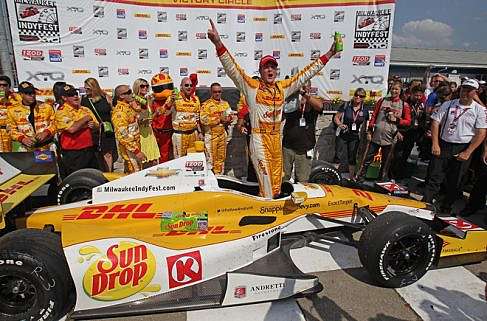Last Sunday, Ryan Hunter-Reay won his first race of the season
at the famed Milwaukee Mile, tightening up the championship race, and providing
a multitude of possible story lines, including the success of the Michael Andretti
-led promotion of the event. Instead, the buzz afterwards focused more on yet another
blunder by the governing body of IndyCar.
During the race, IndyCar penalized championship contenderScott Dixon for illegally passing before a re-start, a decision that resulted
in dropping Dixon down the field, where he eventually finished 11th.
Unbelievably, a failure in IndyCar’s timing and scoring system led race
officials to review the wrong replay
of the re-start, a previous effort that was waved off. There hasn’t been such a
high-profile error in timing and scoring since Arie Luyendyk had to literally
fight for his win at Texas in 1997, and this story only gets worse if it ends
up costing Dixon the series championship.
Losing ground to NASCAR and Formula 1 for mindshare of
American fans, IndyCar can’t seem to either catch or break or get out of its
own way. A quick run-down of hard luck and miscues preceding the Dixon debacle include:
Dirty laundry. Following
the relative success of this year’s Indianapolis 500, IndyCar CEO Randy Bernard
went public on Twitter revealing an unnamed car owner was trying to get him
fired. Unlike the past, today’s IndyCar CEO reports into an independent board
of directors and not the car owners. In probably an unnecessary move, Bernard
put the question of his job security squarely in the glare of the public and media
scrutiny. For a sport that lives by sponsorship, the perception of instability
at the top does no favors.
Illegal parts, but a
legal win. Justin Wilson won the race at Texas Motor Speedway, a great
result for a small team looking to break into the upper echelon of the series.
That was the good news. The bad news was the car utilized illegal body parts.
IndyCar did the right thing by letting the result stand, following NASCAR’s
lead over the years – fans deserve to leave the track knowing who won. The
worst news is that IndyCar couldn’t discover the illegal parts until after the
weekend was over. The perception of lax scrutiny and inspection only erodes
credibility.
Missing pieces. Mid-way through the race in Detroit, the red
flag flew, not for the accident that claimed James Hinchcliffe, but rather for
the cause of Hinchcliffe’s crash – a track
surface that deteriorated and came up in unbelievably large chunks,
necessitating a long delay for patching. IndyCar took a calculated gamble on
the track surface surviving the race weekend, and it lost. One more tick on the
wrong side of the ledger.
Grid barely filled at
Indy. Qualifying for the biggest
race in the world was largely anticlimactic after the race for the pole, as
there simply weren’t enough cars and engines to have attempts by drivers to “bump”
into the field. In the glory days of Indy, Bump Day was every bit as exciting
as Race Day, as tens of cars made the frantic, last moment dash to get into the
field for the richest payday in racing. This year, IndyCar just barely filled the
field, and two of the cars – Di Silvestro and Alesi – were blacked flagged on
race day for failing to keep adequate pace.
IndyCar brings its show to Iowa this weekend, and
desperately needs to put on both a good show and an uneventful show. For a
series that is struggling to overcome the loss of media magnet Danica Patrick
and the tragic death of popular driver Dan Wheldon, the series just can’t
afford another high-profile mistake.
Race along on Twitter @RayHartjen.


No comments:
Post a Comment